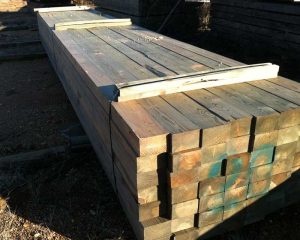Storing Lumber for Your New Post Frame Building
Ideally, use lumber promptly. Otherwise store in a cool, dry location, avoiding direct sunlight and preferably indoors where humidity variations will be minimal.
Dry lumber
Unlike green lumber, keep kiln or air-dried lumber away from moisture, otherwise product may lose value added by careful seasoning. Dry lumber if saturated with water, such as from rain, melting snow or contact with wet ground, can lose dimensional stability, warp and otherwise deteriorate. Lumber exposed to alternate wetting and drying will check, split, warp and discolor.
If stored outdoors, keep dried lumber off the ground and protected by paper, wrapping, tarpaulins, or canvas. Paper wrapping offers short-term protection and, if torn, repair immediately. Dilapidated wrapping holding rainwater may increase moisture regain more than if lumber had no protection.
Why use dry lumber? Lumber grade stamped at a 19% or less moisture content is termed “dry lumber”. Dry lumber is relatively dimensionally stable – meaning shrinkage probability is negligible. University research studies have shown an 8’ long 2×4 will lose approximately 1” in length, when naturally drying. Drying lumber also reduces chances mold or other fungi will attack wood. “Green” (20% or higher moisture content – not color) lumber is prone to warp, cup and split as part of natural drying process. Holding power of nails driven into green wood drying in place drops substantially over time.
Read more about dry vs. green lumber here: https://www.hansenpolebuildings.com/2011/09/499green-lumber-vs-dry-lumber/
Air flow is the most important factor in outside lumber storage. Allow large air volumes to circulate freely around stacked lumber in order to evaporate moisture from lumber. Provide an open storage area with no trees or buildings blocking air flow. Remove weeds, grasses and other vegetation around lumber as they harbor insects and fungal spores.
Good water drainage in storage area is important. Standing water adds to humidity increasing mold and stain possibilities on lumber.
When stacking lumber on stickers (also known as dunnage), place stickers in perfect vertical alignment with one another. Otherwise, sagging will occur. Solid stacked lumber is often stored in packaged units bound with tie straps (or banding) for easier handling. Separate stacked units by spacers, usually at least 4”, and aligned with lower stickers to prevent sagging.
 Storing lumber under a roof offers better protection by keeping material dry and bright.
Storing lumber under a roof offers better protection by keeping material dry and bright.
Lumber, especially pressure preservative treated, is particularly susceptible to warping and twisting while curing. These materials are best incorporated into the new building as quickly as possible. In the event lumber will not be used immediately, keep bound tightly.
Bands placed by lumber company will rarely be adequate to maintain dimensional stability. Tight chains or cable restraints around lumber at frequent intervals, tightened as material dries, may help. Even these measures may be inadequate to prevent lumber warp, twist and bow.
In any case, prior to installation in the new building, protect pressure treated lumber from direct sunlight and rain.






